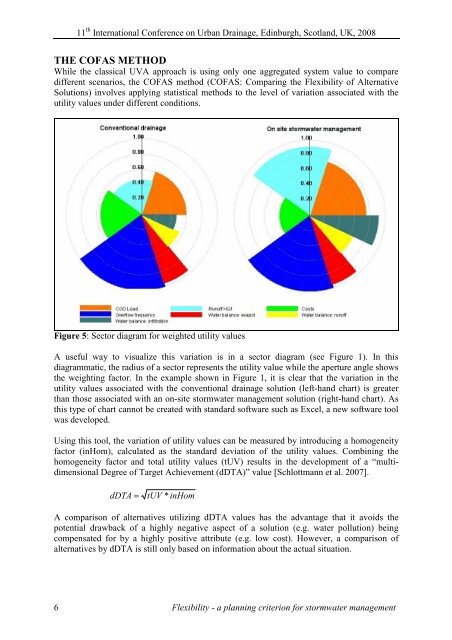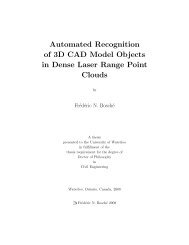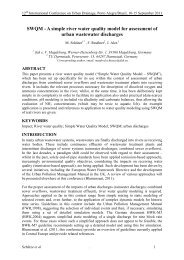Flexibility - a planning criterion for stormwater management
Flexibility - a planning criterion for stormwater management
Flexibility - a planning criterion for stormwater management
Create successful ePaper yourself
Turn your PDF publications into a flip-book with our unique Google optimized e-Paper software.
11 th International Conference on Urban Drainage, Edinburgh, Scotland, UK, 2008<br />
THE COFAS METHOD<br />
While the classical UVA approach is using only one aggregated system value to compare<br />
different scenarios, the COFAS method (COFAS: Comparing the <strong>Flexibility</strong> of Alternative<br />
Solutions) involves applying statistical methods to the level of variation associated with the<br />
utility values under different conditions.<br />
Figure 5: Sector diagram <strong>for</strong> weighted utility values<br />
A useful way to visualize this variation is in a sector diagram (see Figure 1). In this<br />
diagrammatic, the radius of a sector represents the utility value while the aperture angle shows<br />
the weighting factor. In the example shown in Figure 1, it is clear that the variation in the<br />
utility values associated with the conventional drainage solution (left-hand chart) is greater<br />
than those associated with an on-site <strong>stormwater</strong> <strong>management</strong> solution (right-hand chart). As<br />
this type of chart cannot be created with standard software such as Excel, a new software tool<br />
was developed.<br />
Using this tool, the variation of utility values can be measured by introducing a homogeneity<br />
factor (inHom), calculated as the standard deviation of the utility values. Combining the<br />
homogeneity factor and total utility values (tUV) results in the development of a “multidimensional<br />
Degree of Target Achievement (dDTA)” value [Schlottmann et al. 2007].<br />
dDTA = tUV * inHom<br />
A comparison of alternatives utilizing dDTA values has the advantage that it avoids the<br />
potential drawback of a highly negative aspect of a solution (e.g. water pollution) being<br />
compensated <strong>for</strong> by a highly positive attribute (e.g. low cost). However, a comparison of<br />
alternatives by dDTA is still only based on in<strong>for</strong>mation about the actual situation.<br />
6 <strong>Flexibility</strong> - a <strong>planning</strong> <strong>criterion</strong> <strong>for</strong> <strong>stormwater</strong> <strong>management</strong>













